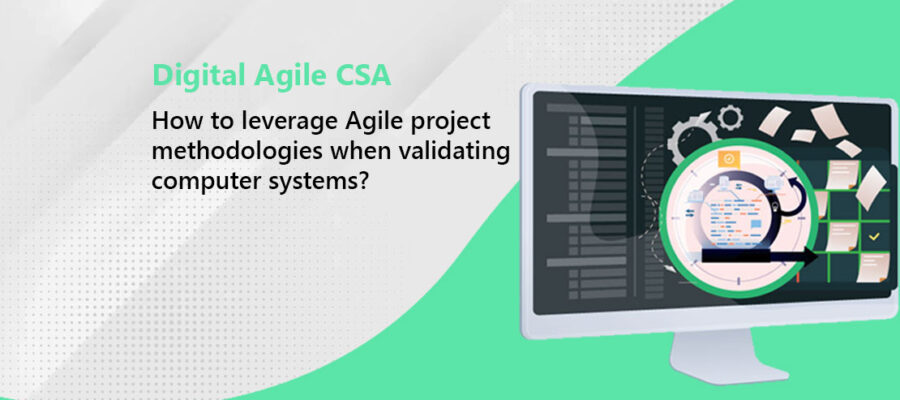Digital Agile CSA | How to leverage Agile project methodologies when validating computer systems?

Article Context:
Technology advancements have compelled organizations to alter business models and practices for meeting the challenges and expectations of their customers. The business approach to develop software, perform validation/testing and maintaining a system post release throughout the entire SDLC (Software Development Lifecycle) should be considered carefully to meet ever changing needs, regulatory and business requirements.
Follow an incremental approach in adoption when using a SAFe framework. Success will be in frequent and continuous process improvements.
SAFe Framework:
SAFe provides an integrated and comprehensive framework for implementing Agile methodologies at an enterprise level, including program and portfolio management. According to the SAFe framework, development cycles are called "Iterations" or "Sprints". These development cycles are relatively short and can go anywhere from a week to a month (most organizations iterations last for a length of two weeks).
During each development cycle, the team collaborates as a single unit to deliver a working part of the software based on the customer demands and expectations. At the end of each sprint, the team will present the accomplished work (A.K.A: User Stories) and right after that review a new iteration that based on new tasks can start. If there are multiple sprints, you assess the impact of each sprint on sprint on prior validated functionality. After the final (hardening) sprint, approval of the requirements docs occurs, regression test as needed and release through normal deliverables.
Why SAFe Framework?
- Accelerate Time to Market
- Early & Continuous Customer Validation
- Greater Visibility into Project Progress
- Early Defect Detection & Prevention
- Risk Reduction & Quality Improvements
- Improve Team Morale
- Faster validation cycles due to frequent releases for testing as development works on the next sprint
SAFe Framework vs other Methodologies:
The main difference between SAFe and other traditional models is that in SAFe we perform design per iteration (Planning meeting) and not in one centralized phase like the one we have in the waterfall model. The SAFe framework is different from other methodologies for the following reasons:
1. Real AgilityThe main advantage of Scrum is that it allows the organization to manage projects with the ability to progress based on the current status and completed work.
2. Iterative ModelBoth large and small projects are divided into small iterations (2-4 Weeks) that allows both the team and the customer to make sure they deliver the product based on the customer’s intended use.
3. Communication and CollaborationThe scrum framework contains a few basic ceremonies that increase the close communication between the project stakeholders. The ceremonies are known as Daily meetings (which help to increase the communication among the team members and to make sure they all share the right goals), Planning Meeting (which determine the amount of work that need to be done to provide an incremental release of the product), Review meetings (which help the project stakeholders to review the work done by the team and to decide how to proceed ) and Retrospective meetings (which help the team to achieve a continues improvement).
4. Continuous DeliveryAt the end of each sprint (A.K.A: Cycle), the team will deliver an incremental release of the software solution.
5. Increased VisibilityThe scrum framework provides a great mechanism to allow an increasing visibility of all the project aspects by using built-in artifacts such as the Product Backlog, Velocity, and Burndown charts.
| Waterfall | Agile |
|---|---|
| Heavy up-front Analysis | Light weight requirement analysis |
| Heavy up-front Planning | Planning spread across entire project |
| Resistant to change | Embraces Change |
| More about process than the product | Light weight process |
| Focus on how it is done | Focus on working product |
| Keeps customers at bay | Frequent customer involvement & Collaboration |
| Wait time of months/years | Incremental, frequent delivery |
The Agile Manifesto
"Our highest priority is to satisfy the customer through early and continuous delivery of valuable software."
We are uncovering better ways of developing software by doing it and helping others do it. Through this work we have come to value:
- Individuals and interactions over processes and tools
- Working software over comprehensive documentation
- Customer collaboration over contract negotiation
- Responding to change over following a plan
There’s value in all the above items, but when push comes to shove, we must value the ones that deliver quality results.
Is your Validation procedure flexible enough to allow an Agile approach? Have you adopted an Agile framework in your deployment systems to achieve efficiency? Are you looking for a breakdown of Agile Myths and Misconceptions? Are you looking for a toolset that adopts and uses Enterprise Agile? If so, we can help. Our Digital SAFe (Scaled Agile Framework) framework is based on agile methodology principles which highlights incremental development, adaptive planning, improved flexibility, increased quality, better customer collaboration and continuous integration and testing.
Our team of CSA/CSV experts who hold high experience in implementing SAFe Agile framework can assist you in achieving your software development and validation goals.
If you are looking for the adoption of Agile methodologies in your SDLC, want faster validation cycles with better results and want your developers to be able to work continuously as they hand off sprints for formal testing, you need Agile principles included in your software validation procedures.
As always, we’re here to help. Contact us at sales@complianceg.com
